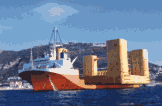What's happening in production
SPR: Sell high, buy low; a new produced-water sampling methodDuring the past three years, the U.S. government has sold 29 million bbl of crude from its Strategic Petroleum Reserve (SPR), apparently for budgetary purposes. Now that the government is seemingly awash in money (about a $100 billion per year projected surplus) and the price of oil near record lows, isn’t this the perfect time to buy back some of those barrels? IPAA and the Petroleum Industry Research Foundation, Inc. (PIRINC) think so. PIRINC says "The SPR is one of the most effective policy tools in minimizing dislocations to the U.S. economy from a disruption in international oil markets." If the government were to act, it would be buying back barrels for about 60% of what it sold them for in 1996. By stimulating higher demand and discouraging domestic supply, today’s low oil prices will raise future import requirements. Higher imports means the current SPR level will provide fewer days of emergency supply. Buying oil now helps maintain a critical insurance policy for the country. Energy Secretary Bill Richardson has proposed a royalty-in-kind swap for the SPR, whereby DOE would take delivery of 100,000 bopd from Gulf of Mexico producers in lieu of federal royalty payments (see also page 9). However, IPAA chairman Bill Yates said 10 million bbl is not enough. The SPR has the capacity to hold 112 million additional bbl if completely filled, which is what IPAA ultimately wants. "We are in an emergency with domestic production," Yates said. "It’s a great bargain for the government and for taxpayers. If there’s a reason to have [the SPR], now is the time to fill it." Overboard water analysis. Most producing locations that deal with overboard water have some method for ensuring regulatory compliance for oil content. This has typically been accomplished by stripping oil from a sample using liquid Freon, then using infrared absorption to quantify the sample’s oil content. Since the use of Freon must now be eliminated, hexane extraction seems to be the most logical alternative. Turner Designs introduced a new portable fluorometer, the TD-360, which uses ultraviolet fluorescence and eliminates the need for Freon. The company promises fast (4.5 min.) results and says its new method eliminates the need for transfer of exact volumes and hexane evaporation. Other features include compensation for lamp degradation (no drift) and a unique, solid calibration standard. For information, telephone 408-749-0994 or go to www.turnerdesigns.com. Operators may also want to consider continuous monitoring. An interesting article, "Saga Petroleum benefits from continuous monitoring of produced water," can be found at the SPE-UK website (www.spe-uk.org). According to Kjell Thorbjornsen, Saga Petroleum UK’s environmental supervisor, a new monitoring system on Snorre platform, offshore Norway, has led to improved control of overboard water — resulting in an overall reduction in discharges. Continuous monitoring has offered a number of measurable benefits on Snorre platform, including reducing costs of chemicals and knowing the 24-hour average, maximum and minimum plant performance data. As a management tool, it calculates daily discharges accurately and provides immediate warning of an incident on the platform. Further, the logged data also can be used as a management tool. Production from Snorre started in August 1992, and the field currently produces 180,000 bopd and 70 MMcfgd for export. Water production stands at around 110,000 bpd.
Troll C FPU arrives. The floating production unit (FPU) hull for Norway’s Troll C field arrived safely in Haugesund, Norway, in mid-January after a six-week journey from Ulsan, Korea. The FPU consists of four floaters grouped in a square ring. Built on a normal construction quay instead of inside a dry dock, the hull structure was loaded using a skid-on method. After 16 days of preparation, it took just five hours to load the 14,000-ton structure onto the Mighty Servant 3, a heavy transport vessel operated by Dockwise. To protect the transport vessel’s stern, the hull was shipped in the unique manner shown in the accompanying photo. This resulted in an unusual buoyancy effect when the ship was rolling. ABB will supply the world’s first, complete subsea oil separation and water reinjection plant for Troll C. The subsea oil separation plant should substantially reduce oil field production costs. Troll C is located in the Norwegian sector of the North Sea, 60 km west of Bergen, at a depth of 1,100 ft. With the help of the planned Troll C FPU, it will be possible to recover an additional 300 million bbl of oil from the field. This raises the amount of recoverable oil reserves from Troll to about 1.2 billion barrels. First oil. Chevron, Exxon and Petrofina celebrated first oil February 1 from the Genesis project in the Gulf of Mexico, located about 150 mi south of New Orleans in 2,600 ft of water. Genesis uses a unique, floating-spar platform — the first to accommodate both production and drilling operations. Projected production from Genesis should reach 30,000 bopd and 20 MMcfgd in 1999. Peak
capacity of 50,000 bopd and 72 MMcfgd is anticipated in 2000. This is Chevron’s first
deepwater development. Copyright © 1999 World
Oil |
- Applying ultra-deep LWD resistivity technology successfully in a SAGD operation (May 2019)
- Adoption of wireless intelligent completions advances (May 2019)
- Majors double down as takeaway crunch eases (April 2019)
- What’s new in well logging and formation evaluation (April 2019)
- Qualification of a 20,000-psi subsea BOP: A collaborative approach (February 2019)
- ConocoPhillips’ Greg Leveille sees rapid trajectory of technical advancement continuing (February 2019)




